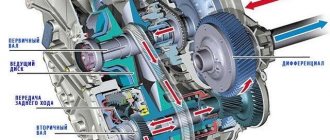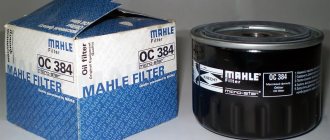Continuously variable transmissions, which provide smooth changes in speed, have been widely used in the automotive industry since the early 2000s. The owner needs to periodically check the condition of the vehicle and change the oil in the variator, ensuring an increase in the service life of the unit. If the maintenance regulations are violated, the wear of the bevel pulleys and leaf chain accelerates, which leads to expensive repairs.
When to change the oil in the variator
Replacing the lubricant in the variator is carried out in strict accordance with the regulations, which each automobile manufacturer has its own. On average, it is recommended to carry out maintenance at least once every 40 thousand kilometers.
The replacement interval is reduced if the vehicle is operated in unfavorable conditions:
- regular and prolonged towing of trailers or other vehicles;
- dynamic driving style with fast acceleration and braking;
- long periods of vehicle idle time in traffic jams at high air temperatures;
- frequent wheel slip and movement over rough terrain;
- operating the car in the mountains, driving on dusty and/or dirty roads.
If a check light lights up on the dashboard or a hum is heard while driving, there is vibration or an unpleasant burning smell appears - these are good reasons to check the level and condition of the oil in the CVT (continuously variable transmission).
How to choose high-quality transmission fluid for a CVT
Information about the transmission fluid that is suitable for your vehicle's CVT can be found in the vehicle's service manual, vehicle service book, or directly on the continuously variable transmission dipstick, which can be found under the hood of the car. It is there that the factory approval is indicated, which will help you choose the highest quality oil for the variator of your vehicle.
For example, Nissan brand CVTs are filled with oil with NS-1, NS-2 or NS-3 approvals.
For CVT Toyota, it is recommended to use transmission fluid with the specification CVT Fluid TC or CVT Fluid FE.
HMMF factory approval helps you select high-quality transmission fluid for continuously variable transmissions in Honda vehicles.
And for CVT cars of the Mitsubishi brand, the oil is selected according to the CVT Fluid J1 or CVT Fluid J4 tolerances.
How to check the condition of the oil in the variator
Before changing the transmission oil in the Jatco variator, the current condition of the fluid is assessed. This will give a final understanding of whether the time has come for automatic transmission service or not. There are two simple and proven ways to check the oil level in the box and assess the quality.
Drop test
Before the drop test, the engine is warmed up - the level and properties of the liquid are assessed when it is heated to 50-80 ° C. Then place the car on a flat horizontal surface and do not turn off the engine; it should be idling.
Take out the variator dipstick - it is located in the filler neck. This place can be found by the inscription "CVT" or "TRANSMISSION".
When you find the dipstick, start checking the oil:
- Press the dipstick lock to unlock it and remove it from the neck.
- Wipe the metal part dry with a rag.
- Immerse the dipstick back into the neck until it stops and hold for several seconds.
- Take out the part again and carefully inspect the oil trace on it.
In normal condition, the fluid on the dipstick reaches an average level between the maximum and minimum marks. As for quality, to evaluate it, drop a little lubricant onto a clean white napkin. If the liquid is cloudy, it means there is a high concentration of wear products.
Next, evaluate the smell of the oil: burnt indicates regular overheating of the liquid. This often happens due to incorrect operation of the cooling system or due to low pressure. For a more objective comparison, it is advisable to prepare a sample of pure oil.
Transmission fluid aging counter
Modern cars are equipped with an electronic CVT control unit, one of the functions of which is to calculate the remaining life of the transmission fluid. For this, a special mathematical algorithm is used: there is no doubt about the accuracy of the assessment of the “old age” of the oil.
Owners of Nissan and Toyota CVT cars have the opportunity to assess the condition of the lubricant using a meter. Limit recommendations vary from one automaker to another. For example, Toyota recommends changing the oil when the meter reaches 210 thousand units.
Checking the fluid level
Since CVT malfunctions are sometimes associated with low oil levels and not with its quality, it is recommended to periodically check the amount of lubricant. This is done within the framework of each maintenance and in the intervals between them.
In most cases, you can follow the same instructions on how to properly check the lubricating oil level in the variator yourself. To do this you need:
- place the car on a level surface;
- warm up the engine;
- squeezing the brake, switch the selector to each of the available positions;
- hold in each position for 10 seconds;
- switch to parking mode;
- open the hood, wipe the outside of the dipstick;
- pull out the dipstick, removing any remaining oil from it;
- return it to its place, hold it for 5 seconds and pull it out again;
- look at the probe marks (checking the hot level, hot);
- put the dipstick in place.
Based on the marks, you can find out how much lubricant is currently in the CVT and whether the current level corresponds to the required volume of lubricant.
In fact, checking the lubricant level is not much different from how you can measure the oil level in an engine. So everyone can easily cope with the task.
How to properly change the oil in a variator with your own hands
If, according to the regulations, the time has come to replace the CVT fluid, you can try to cope with the task yourself. There are two ways - partial and complete renewal of transmission oil.
It is impossible to carry out a complete replacement efficiently in a home garage, since this requires a special apparatus. It is only available at the service center.
The specialists at the CVT Repair Center No. 1 will help you cope with tasks of any complexity. Get additional information by calling: Moscow – 8 (495) 161-49-01, St. Petersburg – 8 (812) 223-49-01. We accept calls from any region.
Partial
Before moving on to a partial replacement of transmission oil, prepare fresh fluid in a sufficient volume. First read the vehicle's operating instructions, as the manufacturer specifies in it which lubricant should be filled in and in what quantity.
Prepare an empty container with a capacity of at least five liters - it is needed to collect waste liquid. Consumables will require a new pan gasket and an oil filter for the variator.
Before replacing the fluid, warm up the transmission - just drive the car about 10 kilometers. Then they park the car on a flat road and wait about an hour. This is necessary so that the oil flows back into the pan. After this, the procedure begins immediately:
- Place an empty container under the variator drain plug and unscrew it.
- Wait until all the transmission fluid has drained out.
- Unscrew all the bolts holding the pallet and carefully remove it.
- Rinse the tray and remove metal shavings deposited on the magnets.
- Disconnect the solenoids and dismantle the valve body, then wash it.
- Replace the fine paper filter (located behind the heat exchanger).
- Change the metal coarse filter (installed in the pan).
- Dry the hydraulic unit and pan, and then install them in place.
After completing the assembly of the variator, check that its pulley is completely aligned with the valve body pulley. To do this, switch the automatic transmission selector several times to different positions and make sure that all shifts work correctly without jamming or squeaking.
The final stage is filling the transmission with new oil through a special hole. When this is ready, check the fluid level using the dipstick. If necessary, add oil. After successful replacement, the aging counter is reset - a diagnostic tool is needed for this.
Despite the theoretical possibility of changing the fluid in a continuously variable transmission yourself, it is strongly recommended to entrust this task to experienced professionals from a service center.
Full
A complete change of transmission oil in the variator is carried out using equipment that is at the disposal of the service center. The device supplies new fluid under pressure inside the automatic transmission, due to which the old oil, along with chips and deposits, is forced out of cavities and hard-to-reach places.
We invite you to watch a detailed video review of changing the oil in a variator.
The importance of lubrication for the functioning of the variator
The variator design has driving and driven cones; torque is transmitted by a plate steel chain. Special oil creates a thin layer that provides an increased coefficient of friction and at the same time reduces wear rates. The liquid removes metal dust, which can destroy bearings and damage the surfaces of cones or belts. The lubrication system has a filter that traps foreign impurities.
When the oil degrades, the operating conditions of the gearbox worsen, which leads to the vehicle going into emergency mode and failure of the unit.
To separate impurities, an external fine filter is used, located near the heat exchanger. On some CVT models (installed, for example, on a number of Mitsubishi cars) such an element is not provided. Inside the pan there is a coarse filter, which is changed only when the box is fully serviced.
Which is better – complete or partial fluid replacement?
You cannot get by with only partial replacement of transmission oil over a long period of time. The fact is that when adding fluid, it is impossible to completely get rid of the chips that appear as a result of friction of the mechanisms inside the variator. Over time, it penetrates deeper into the design of the continuously variable transmission, eventually reaching the torque converter.
A complete oil change is something you shouldn't skimp on. You need to contact a car service, which takes time and money, but in the future, repairing the variator will cost more.
Misconception The CVT has no steps
Yes and no at the same time. This postulate is refuted by gearboxes that have both a belt variator and a two-stage gearbox. Our car enthusiasts first saw it on the Nissan Juke, and now it has reached the Lada Vesta. It is produced by Jatco (Japan), index - JF015E. The bottom line is that the variator provides approximately half of the entire speed range in first gear, and then, when moving to second, it again realizes its range. Thus, in the classical sense, this variator has two gears. But most transmissions like this are also trained to simulate five or six gears electronically. These programs are, of course, “not real”, virtual.
Toyota's newest Direct Shift-CVT uses gear first gear and then engages a belt with cones.
Toyota's newest Direct Shift-CVT uses gear first gear and then engages a belt with cones.
Difficulties and nuances of self-replacement
First of all, there is a risk of encountering a counterfeit when choosing gear oil. The market for consumables for cars is filled with counterfeit goods, and without proper experience and knowledge it is easy to buy counterfeit fluid. The consequences of its use are disastrous.
The second problem that many car owners face when trying to change the oil at home is the complexity of the process. You need a set of tools, an inspection hole, patience and free time, and even this does not guarantee success.
During maintenance, you can damage fragile mechanisms, forget parts during assembly, or make other serious mistakes.
Changing the oil in a variator at a car service center
The optimal solution to the issue of changing the oil in a continuously variable transmission is a visit to Jatco service. Since 2008, experienced craftsmen have been servicing Japanese CVTs around the clock. In addition, we maintain a low cost for changing transmission oil in a variator and provide a tow truck service to the service center completely free of charge.
You can diagnose and fix problems of any complexity at the CVT Repair Center No. 1. Get additional information by calling: Moscow – 8 (495) 161-49-01, St. Petersburg – 8 (812) 223-49-01. We accept calls from any region.
We invite you to contact the service right now, get a free consultation and find out how much a partial and complete oil change costs for the CVT model in your car.
Hardware oil change
Hardware oil change is a modern technology for servicing a variator using pumping equipment. But this method has its pros and cons.
Pros:
efficient pumping out of most metal shavings and deposits;
there is no need to disassemble the pan and hydraulic unit, which speeds up the procedure;
relatively low cost due to ease of operation;
there is no need for special tools, or a pit or overpass.
The downside is that during the procedure it is not possible to visually check the condition of the variator mechanisms from the inside, since this requires disassembling the unit. But on the other hand, if necessary, such a check will still be carried out.
As for the cost of hardware oil change, it is calculated on the spot. The price of the service is calculated in the presence of the car owner, so everything is fair.
Do I need to change the filter when changing the oil?
CVTs from the manufacturer Jatco are factory equipped with two filters:
- Disposable fine cleaning cartridge. Absent on some modifications, including the F1CJA and W1CJA versions. This element must be changed at every oil change. Its cost cannot be called high.
- Metal coarse filter. This part must be replaced every time the transmission fluid is changed. Otherwise, you can save money, but before that you need to clean the filter from metal shavings.
Reuse of the coarse filter is not allowed if its lattice part is clogged with resinous glue, which is used in the construction of friction linings.
We invite you to watch a video review of changing the oil and filters in the CVT of a 2012 Nissan Qashqai.
Gearboxes installed on the second generation Nissan Teana (J32)
The main years of production of Teana-2 were from 2008 to 2013; for some time, assembly of this model continued to be carried out in Iran and Taiwan.
For all regions, the car was supplied only with a continuously variable transmission (CVT) from Jatco, but depending on the type of engine and year of manufacture of the car, different modifications of the variator were provided:
- JF011E, another name – RE0F10A, was installed in tandem with a 2.5-liter V6 VQ25DE engine (front-wheel drive) or with a 4-cylinder power unit of the same volume QR25DE (4WD all-wheel drive);
- JF016E (RE0F10D), also came with a 2.5L 4-cylinder internal combustion engine, but after restyling (starting from 2012);
- JF010E (RE0F09B), intended for cars with 3.5-liter engines.
It should be noted that there are few Teana-2 sedans with the JF016E gearbox in Russia, and they are mostly right-hand drive. This box began to be installed en masse on the next generation model L33.
Therefore, with 2.5L engines, JF011E gearboxes were mainly supplied in three modifications, depending on the year of manufacture and the type of power unit (310201XF8E or 310201XT4A - with VQ25DE internal combustion engine, 31020-1XT6C - with QR25DE engine).
Therefore, if you want to change the oil in a Nissan Teana J32 automatic transmission, then check, most likely the car has a CVT.











